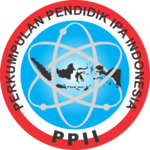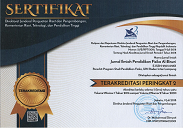Griddle and Chimney Conductivity in a Husk Furnace: An Influence of Oxygen Flow and Orifice Size
Abstract
This research investigates the effect of oxygen flow valve orifice size on the thermal conductivity of a small-scale industrial husk furnace's pan and chimney. The researchers used a water boiling test to the thermal conductivity at varying valve hole sizes: 3627 cm, 3634 cm, 4334 cm, and 5034 cm. The pan, crucial for direct contact with cooking ingredients, and the chimney, responsible for fire flow during combustion, play vital roles in heating. The chimney, constructed of clay and zinc, exhibited thermal conductivity values ranging from 0.52 to 0.59 W m⁻¹ °C⁻¹. The highest chimney thermal conductivity was observed at the 50x34 cm valve hole size, attributed to a smaller temperature difference between the inner and outer chimney surfaces. The pan's average thermal conductivity ranged from 2.95 to 4.10 W m⁻¹ °C⁻¹, with the highest value recorded at 5034 cm orifice. This finding suggests a direct relationship between the valve hole size, heat transfer rate, and the pan's thermal conductivity. The research reveals the influence of oxygen flow on heat transfer within the husk furnace, providing valuable insights for optimizing its design and efficiency. While the chimney's thermal conductivity remained relatively stable across different orifice sizes, the pan's conductivity showed greater variation, potentially indicating inconsistent heat distribution. Further research with more precise temperature measurement techniques is recommended to refine these findings.
Keywords
Full Text:
PDFReferences
Dondi M, Mazzanti F, Principi P, Raimondo M, Zanarini G. 2004. Thermal conductivity of clay bricks. Journal of Materials in Civil Engineering. 16(1):8-14. doi: 10.1061/(ASCE)0899-1561(2004)16:1(8) .
Forsberg CH. 2021. Heat Transfer Principles and Applications. London: Academic Press.
Hanifan RAN, Hajar S, Har NP, Zuhri M, Rustami E, Nikmatin S, Irzaman. 2023. Efficiency improvement, design optimization, and expansion of oxygen flow valve holes in small industrial scale husk furnaces. Jurnal Ilmiah Pendidikan Fisika Al-Biruni. 12(2): 231-242. doi.org/10.24042/jipfalbiruni.v12i2.18960.
Iskandar S. 2014. Perpindahan Panas. Ed ke-1. Yogyakarta: Deepublish.
Iskandar T, Siswati ND. 2012. Pemanfaatan limbah pertanian sebagai energi alternatif melalui konversi thermal. Buana Sains. 12(1): 117-122. doi.org/10.33366/bs.v12i1.158.
Lienhard JH, V, Lienhard JH, IV. 2024. A Heat Transfer Textbook. 6th Edition. Cambridge: Phlogiston Press.
Mirmanto, Mulyanto A, Hidayatullah LR. 2014. Hubungan ketinggian dan diameter lubang udara tungku pembakaran biomassa dan efisiensi tungku. Jurnal Teknik Mesin (JTM). 6(4): 225-230.
Pangestu SF, Hiendro A, Taufiqurrahman M. 2023. Analisis konduktivitas termal material logam menggunakan metode Searle. Jurnal Rekayasa Teknik Mesin (JTRAIN). 4(1): 44-48.
Parunduri L, Parinduri T. 2020. Konversi biomassa sebagai sumber energi terbarukan. Journal of Electric Technology (JET) . 5(2): 88-92.
Prihartono J, Irhamsyah R. 2022. Analisis konduktivitas termal pada material logam (tembaga, alumunium dan besi). Jurnal Presisi. 24(2):49-54.
Rani CS, Kandpal TC, Mullick SC. 1992. Preliminary study of water boiling test procedures used for performance evaluation of fuelwood cookstoves. Energy Conversion and Management. 33(10): 919-929. doi: 10.1016/0196-8904(92)90106-7.
Saputra A, Samhuddin, Hasanuddin L. 2022. Perancangan dan analisis pengujian konduktivitas panas pada tipe material padat. ENTHALPY: Jurnal Ilmiah Mahasiswa Teknik Mesin. 7(1): 22-27. http://dx.doi.org/10.55679/enthalpy.v7i1.24502.
Sidebotham GW. 2015. Heat Transfer Modes: Conduction, Convection, and Radiation. Heat Transfer Modeling, 61–93. doi:10.1007/978-3-319-14514-3_3.
Sulasminingsih S, Hafiz F, Sari K, Yuninda S. 2023. Penggunaan biomassa sebagai energi alternatif pembangkit listrik di wilayah pedesaan. Jounal of Optimization System and Ergonomy (JOSEON). 1(1): 42-51. Doi: 10.54378/joseon.v1i1.6766.
Wahyullah, Putra OD, Ismail. 2018. Pemanfaatan biomassa tumbuhan menjadi biopellet sebagai alternatif energi terbarukan. Hasanuddin Student Journal. 2(1): 239-247.
Widianto W, Junaidi, Taufiqurrahman M. 2023. Analisis konduktivitas termal material kaca menggunakan metode Lee’s Disc. Jurnal Teknologi Rekayasa Teknik Mesin (JTRAIN). 5(1): 73-77.
DOI: http://dx.doi.org/10.24042/jipfalbiruni.v13i2.24535
Refbacks
- There are currently no refbacks.

Jurnal ilmiah pendidikan fisika Al-Biruni is licensed under a Creative Commons Attribution-ShareAlike 4.0 International License.
![]()








